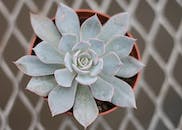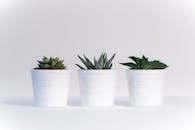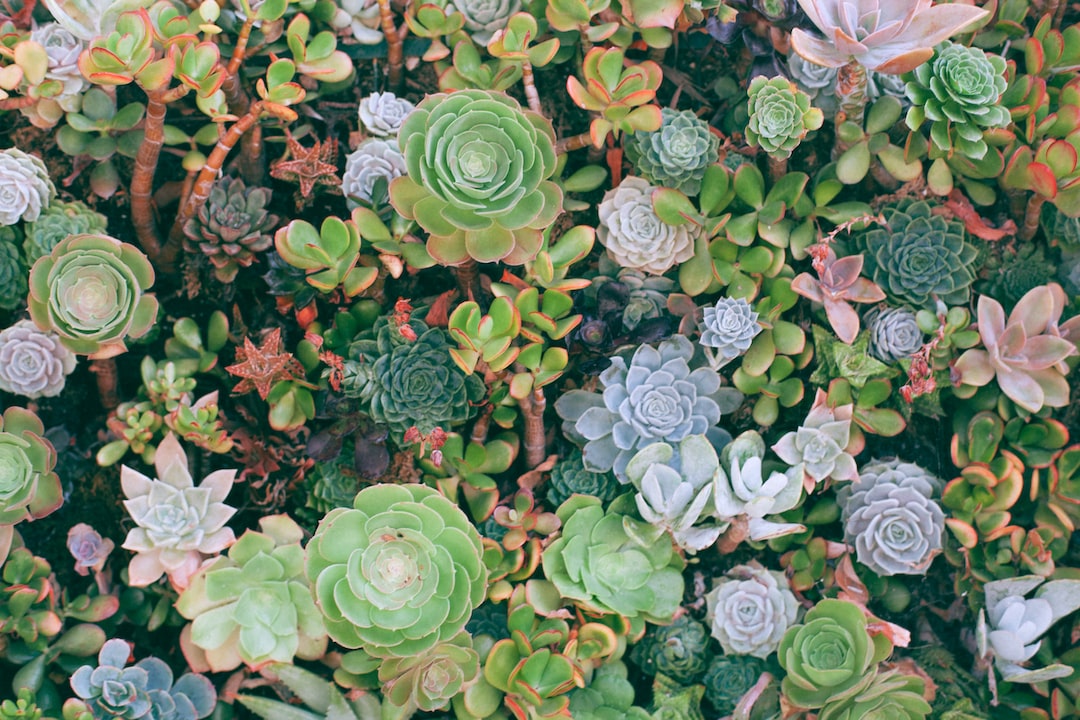HOW BIG DO SUCCULENTS GROW
Succulents come in all sizes, so you can probably find or grow one as big as your location or clay pot allows. Although most households have small succulents in small pots, big succulents can grow to six feet tall. So if you need a large relatively carefree plant head to your nearest gardening center and ask about the succulents. Since succulent species come in all sizes and are somewhat maintenance-free, they are perfect for window sills, balconies, decks and porches and even apartments. I don’t even think one could say there is an average size succulent. And even possibly massive succulents tend to remain small when their roots are confined. So the type of plant and your pot size make a difference. You want a larger plant, get a larger pot.
Give your succulents the best conditions
Offering your succulents the ideal environment and TLC will guarantee they grow and grow. Since succulents hail from environments with great deals of sunlight, they tend to crave an excellent amount of UV rays. Many succulents require more than 6 hours of light daily. Careful with too much light, you might burn your favorite little guy. A permeable and well-draining soil with a loose and rough texture is perfect for succulents to guarantee they aren’t sitting in water for an extended period of time. If you don’t have well-draining soil, you may need to change your watering habits to keep your plants from getting root rot.

Proper Care – Low-maintenance water schedule
This is where the low maintenance part actually comes in when we are talking about watering succulents, when in doubt…don’t. While the frequency of watering will depend on the types and your growing conditions, the majority of succulents need to be left to dry totally between waterings. That suggests your succulent’s soil ought to be bone-dry and crumbly before you give it more water. When in doubt, however, it’s much better to steer on the side of under-watering. Due to the fact that succulents are native to hot, arid climates, they generally prefer warm temperature levels with lower humidity, though it can depend on the type.
Simple Soil
The best soil type for succulents, whether in the ground or in containers, is permeable well-draining soil, meaning a coarse, fast-draining mix. Use a succulent or cactus-specific soil blend and make it wet to assist the plant to take root in the beginning. If using stem cuttings and it takes root, you can repot it in a bigger pot with succulent labeled soil. Remember these are slow-growing plants and your patience is required.
Pick the Right Pot
Choose one that’s an inch or more bigger than their present pot to offer them room to grow. Ensure that it has drain holes, to assist in keeping the roots dry in case of overwatering. The best way is to have well-draining, course sandy soil for your succulents. Using a soil blend that’s produced for succulents or cacti would be ideal.


Loving Care
Even though they’re an easy-care plant, you might discover that your succulent starts to look a little unhealthy. For this particular plant, it is recommended to use a balanced liquid fertilizer. Remember to dilute it to half-strength and apply it once or twice during the spring season. Here’s how to get to the root of the most typical succulent problems. In the majority of cases, overwatering tends to be the factor in a succulent’s failure to grow. An overwatered succulent will have mushy, sagging, yellowing or blackened leaves; will start to lose leaves; and the stem could become swollen. With enough light and the right conditions your healthy succulent will grow new leaves, just remember they are slow growers and new growth may take a long time. They don’t call them slow-growing succulents for nothing. But with ideal conditions, warm temperatures, and adequate light they can reach their full potential. If you do overwater, you should take the plant and the soil out of the pot and let it sit out to speed up drying. Make certain the plant dries out thoroughly prior to you watering again and consider repotting in a pot with drain holes to help reduce the opportunities of the plant taking on too much water.
Sunlight
A lot of succulents grow in both direct sunlight or indirect light like a grow light. Too much sun can burn your succulents, and cause brown areas. On a particularly hot day move your succulents to a shady cooler area.

The Succulent for you
There are hundreds of different types of succulents out there, in all different shapes, sizes, and colors. You can discover some gorgeous succulent choices for your garden or your plant collection. Here are a few of the most typical succulents that work magnificently as houseplants, if you’re aiming to keep a couple of in your warm windows.
The jade plant is a popular succulent sometimes called a money tree. These are long-lived and with care can resemble a small tree like a bonzai. The jade is popular, has interesting thick leaves and a good choice of all the new plants you can choose. This succulent has actually been a popular houseplant option for years, due to its low maintenance practices (just water it every few weeks or so), and bold jade green color. Read on then go find your favorite.
String of hearts plants make excellent hanging houseplants and they bloom, too.
Sedum plants can be found in a variety of different shapes and colors, so odds are you can find among these succulents to suit your taste. They likewise make great landscape plants and ground cover, if you’re searching for a low-maintenance option for a lawn.
And don’t forget the always popular Aloe Vera plant. Beautiful plant and has medicinal uses. Check out this article on the health benefits of the Aloe Vera: Sánchez, M., González-Burgos, E., Iglesias, I., & Gómez-Serranillos, M. P. (2020). Pharmacological Update Properties of Aloe Vera and its Major Active Constituents. Molecules, 25(6). https://doi.org/10.3390/molecules25061324
Cacti are Succulents Too
Like squares are to rectangular shapes, cacti are to succulents. In other words, all cacti are considered succulents, however not all succulents are cacti. Cactus plants can also be identified from lots of common succulent plants since they usually do not have leaves.
When You Say Goodbye
If your succulent gets all mushy, discolored and funky, it is time to say goodbye. When your plant dies, you should discard the infected plant, soil, and all, and scrub the pot before reusing it.
More Fun Succulent Facts brought to you by my AI assistant
When under-watered, succulents subsist on kept moisture. If the soil dries entirely, roots might desiccate and growth stops. Some succulents are capable of regenerating roots when the rains return, however, it’s best to keep soil about as wet as a wrung-out sponge. Boost or diminish the amount of water with these considerations: The type and depth of soil, time of year, relative humidity intensity and period of sun direct exposure, and ambient temperature level.
Varieties that will want more sun and won’t bloom without it are those belonging to the Southwest such as cacti and yuccas, and aloes from South Africa. Succulents do require sufficient light for well-balanced development (so they don’t stretch), and any succulent plant for that matter that has been cultivated in low-light or a greenhouse ought to be hardened off (presented slowly) to greater sun direct exposure.
Variegated (striped) succulents, which have less protective pigment, want less sun than their solid-colored cousins.
The banana belt for outdoor cultivation of succulents year-round is seaside California from the Bay Area south. But no matter where you live, you can have any succulent you fancy; simply grow the picky ones in protected microclimates or containers.
At your house, an outside countertop is a great area for succulents that you prefer not to grow in your outdoor garden.
Cacti are not the only type of succulent. Succulents are also thought of as something that you may stumble through in the desert or a really dry climate.
Taking care of succulents is not as hard as some might think. They don’t need a lot of extra attention or special care, however, there are essential things that you can do to make certain your succulents grow. Use the right container and soil, Succulents do not like to be damp for long periods.
East-facing windows are the best location for indoor succulents. You may be required to filter the light with a curtain in a southern-facing window for these plants to prosper.
They can bring years of delight when properly cared for! If you’re all set to attempt your hand at growing succulents, choose among pre-planted succulent gardens, or pick your own and make a work of art of your own.
Succulents have a reputation for being cannon fodders. As desert natives, they’re accustomed to severe conditions and efficient in surviving both prolonged droughts and severe temperature levels much better than a lot of their plant peers, because they store their own water in their signature thick, fleshy leaves and stems (the word “succulent” is originated from the Latin word sucus, implying “juice”).
There are some shade-loving varieties, most succulents need light lots and lots of light.
When natural light levels are low, mimic the dry-season requirements of a succulent plant by watering it about every 2 weeks; in the brighter summer season, boost to once a week. Regardless of your watering schedule, focus on your plant, specifically if it gets intense light.
“Succulent” describes thick, fleshy plants that have evolved to save water to endure dry climates or difficult soil conditions. Typically the water is kept in the leaves, providing succulents their signature (and irresistibly adorable) look. Other succulents might save water in their stems, and some succulents are geophyte plants with underground organs that save food or other nutrients.
You can find succulents across numerous plant families with dozens of ranges growing all over the world from houseleeks high in the Pyrenees mountains to ice plant, a South African native can be discovered on California’s seaside highways. The number one error house gardeners make is overwatering. Plants need to only be watered when the soil or planting medium is entirely dry.
If the soil is soaked, you can even provide the root ball with a mild squeeze. Leave it to dry in a bright area. In the meantime, clean out the planter completely; it’s best to start by scrubbing with warm water and soap, then follow up a 10 percent bleach solution to sterilize.
After the succulent has had some time to dry, replant in fresh soil. Sadly, there’s no ideal watering schedule. How much to water succulents, as with all plants, will alter by the season, and even by the week. Plants will not require to be watered as regularly in the winter season because the majority of plants go dormant throughout winter; likewise, your plants will require less water throughout a string of cloudy, overcast days.
Succulents, utilized in dry environments where rains is infrequent, store water in their leaves using their root system, which they can’t do if you’re just misting the leaves and leading layer of soil. An accumulation of water on the leaves could likewise lead to decaying. It’s finest to provide succulents a periodic, deep watering, making sure the excess water completely drains off.
Search for consistent wrinkling across the whole plant; if there are only shriveled leaves at the base of the plant, the leaves might simply be older leaves that you can carefully remove. Bear in mind that succulents in small planters will need to be watered more frequently than ones in larger containers or the ground.
You can plant succulents in practically whatever you have, bowls, and hollowed-out logs, the sky’s the limit once you master caring for them. Nevertheless, try to always ensure your planter has a drainage hole. Succulents must never be left in standing water; it quickly leads to root rot, so appropriate drainage is essential.
This article was researched by an artificial intelligent robot and that information was edited with tender loving care by a real human being.
With help from: Succulent plant. (2023, August 18). In Wikipedia. https://en.wikipedia.org/wiki/Succulent_plant
